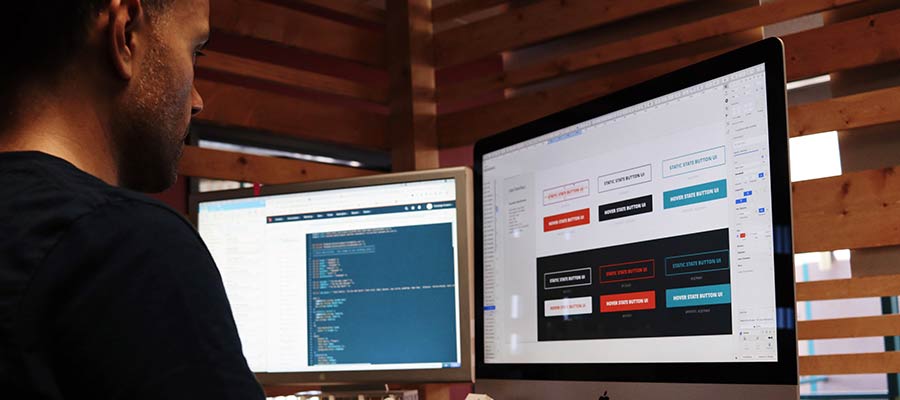If, like me, you started in the early days of the web design industry, you may have worked on both front and back-end projects. Specialization wasn’t yet common – and it probably didn’t need to be. After all, a typical website consisted of HTML, text, and images.
Eventually, CSS and JavaScript came along. But they weren’t nearly as complex as they are today. Thus, it wasn’t unusual to see web professionals add these languages to their repertoire. It seemed as though being a “full-stack” developer, handling both design and development, was manageable.
Fast-forward to today, and the industry has become massively complex. There is a multitude of ways to build a website. And the bar for great design has only gotten higher. Not to mention the ever-growing array of available tools and technologies.
The result is that being a full-stack web developer is more challenging than ever. For industry veterans, it can be a struggle to keep up with both worlds. And for beginners, it may seem like a monumental task.
It’s worth asking whether full stack web development is a realistic option in modern times. Can one person do all of this effectively?
Yes, it’s still possible. But it does require a lot of dedication and a willingness to learn. If this sounds like you, read on for some tips on making it work.
Don’t Let the Terminology Scare You
The title of “full-stack” can be a confusing one. And there’s been a lot of gatekeeping around who gets to label themselves this way.
However, that’s not the aim of this article. The term shouldn’t be exclusionary. Anyone who works on both the front and back ends of a website is full stack in my book – myself included. There’s no complicated litmus test.
But all of the related chatter does lead to a bad case of imposter syndrome. We may feel like we don’t qualify, simply because we haven’t mastered a particular language (or still need to look up answers on Stack Overflow).
The reality is that none of us are perfect, nor do we have infinite wisdom. It’s OK to have strengths and weaknesses. This is all part of the journey.
Therefore, don’t let the opinions of others convince you that you’re somehow less than worthy. Worse yet, don’t let it stop you from trying. There’s plenty of room for you at the table!

Having Front and Back-End Knowledge Is Valuable
If you’ve dabbled in full-stack web development or are interested in getting started, there are plenty of reasons to dive in. Perhaps the biggest is how valuable it is to have some level of knowledge in all areas of the web design process.
A grasp of the various concepts involved makes it easier to plan, design, and build. This holds whether you’re working as a solo freelancer or as part of a team.
Understanding, for example, how to design an accessible website ensures that it will be at the top of the priorities list. Then having the relevant knowledge of HTML and CSS allows you to put those concepts into action.
It’s also quite useful when collaborating with other designers and developers. Knowing the requirements helps to facilitate communication and set specific project benchmarks.
Even if you’re not actively writing code or doing design work, those skills are priceless.

Staying On Top of Your Stack
There are often misconceptions about keeping up with the latest trends, features, and best practices. It’s important to have a basic understanding of them. However, you don’t need to immediately begin implementing everything you see.
WordPress serves as a great example. If you use it to build websites for your clients, you have probably heard about the introduction of block themes. It’s a big change from the now-classic themes that have been utilized for years.
While it’s worth experimenting with this new way of design and development, it’s not a requirement. There’s no need to abandon your existing workflow just yet.
There tends to be a lot of buzz around these types of developments. Try to see them as more of an educational opportunity and less of an immediate call to action.
As things continue to evolve, there is constant pressure to become an expert. But that’s not likely to happen overnight. It’s a process that can take significant time. As such, there’s no need to rush.
Instead, take a step back and try to determine how and if it fits into your future.

The Ingredients for Full Stack Success
If you have an eye for design and a knack for writing code, you’re a great candidate for being a full-stack web developer. But success requires a few key ingredients.
First, you’ll need a desire to learn. Web design is in a constant state of change. Picking up new skills and keeping tabs on the latest design trends is a must. And while you don’t need to be an expert in any one area, working knowledge is crucial.
Being detail-oriented is also a must-have trait. That means employing best practices and making sure that you produce quality work. Rushing through either design or development can lead to issues down the road. Each side is of equal importance.
Speaking of which, there’s also a lot to be said for having efficient, repeatable processes. Finding the right tools and a workflow that allows you to manage all aspects of a project will help you keep things moving forward.
Going the full stack route isn’t necessarily a great fit for everyone. But if you’re passionate about web design and development, it’s still a path worth taking.
Related Topics
Top